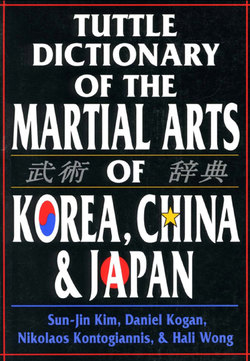Читать книгу Tuttle Dictionary Martial Arts Korea, China & Japan - Daniel Kogan - Страница 5
На сайте Литреса книга снята с продажи.
ОглавлениеINTRODUCTION
This book was inspired by the genuine desire of its compilers to someday learn the true essence of the traditions of the Asian martial arts. As the martial arts are an expression of Asian values and a cultural heirloom that for most of its history, with the exception of a few notable classic works, has been transmitted as an oral tradition from master to student, today most serious students of the martial arts find it necessary at some point to learn, to some degree, the native language of their respective arts.
To this end, we have compiled this work, a list of relevant names of masters, styles, locations, schools, basic vocabulary of the major religions and philosophies, technical martial arts jargon, as well as common everyday vocabulary that one might encounter while learning, researching, or teaching the martial arts.
Having expressed our intent, we humbly submit this work as a first step in what is a never-ending endeavor. Due to the secret nature of many martial arts, the vast geographic areas they have touched, the countless dialects, and centuries of human history they have spanned, it would be unrealistic to believe that we have by any means compiled an exhaustive list. Although great pains were taken to ensure the accuracy of all materials in this book, some readers with firsthand experience in some of the more obscure arts might find faults or omissions in this work. For that we offer our sincerest apologies and ask for the reader's understanding. Although perfection was our aim, we quickly learned that like the martial arts themselves, our final objective is not a stationary point but rather a moving target. The more the details were checked and verified, the more unrealistic it became to include every relevant entry. Considering the volume of information used and cross-referenced when compiling this work we are confident in its ability to stand on its own merits.
This work concentrates on the major languages of the most commonly practiced martial arts (Cantonese, Japanese, Korean, Mandarin, and Okinawan). This is by no means to say that other dialects or national languages have not added relevant vocabulary, but simply that in the interest of brevity and accuracy, we chose to concentrate on those languages that were the basis of our own studies of the martial arts.
We would like to thank Antonio Flores, Alexander Kask, Scott Shaw, and Meik Skoss for their assistance with the proofing and editing of this text. We would also like to acknowledge the following people without whom this book could not have been completed: Naz Bhayani, Carmen Choy, Rick Dove, Martin Drastil, Robert Gough, Robert Kacpura, Vicki Koh, Rodney Lee, Vincent Liew, Ali Novin, Catherine Walters, and Annette Yang.
